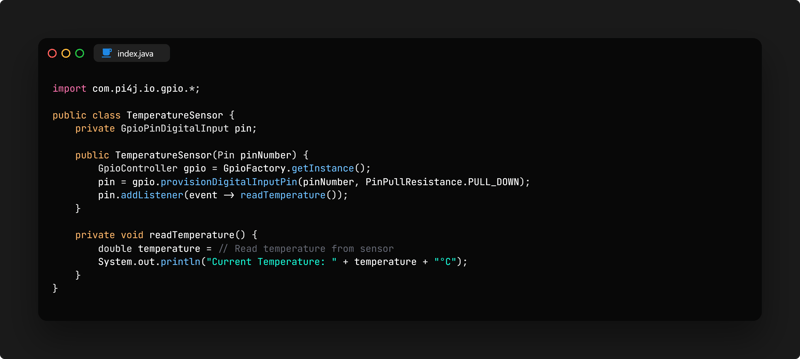Introduction
The Internet of Things (IoT) is revolutionizing how we interact with the world around us. Java, with its robustness and portability, is an excellent choice for developing IoT applications. This article will guide you through creating a smart application using Java.
Why Java for IoT?
Java’s platform independence and strong community support make it ideal for IoT’s diverse ecosystem. Its “write once, run anywhere” (WORA) principle ensures that Java applications can run on a wide range of devices.
Setting Up the Environment
Begin by setting up your Java development environment. Install the Java Development Kit (JDK) and choose an IDE like Eclipse or IntelliJ IDEA. For hardware, a Raspberry Pi can serve as an affordable and powerful IoT device.
Developing a Simple IoT Application
in Java We’ll create a temperature monitoring system using a Raspberry Pi and a sensor like the DHT11 or DHT22.
Connect the Sensor: Attach the temperature sensor to the Raspberry Pi.
Install Java: Ensure the latest version of Java is installed on the Raspberry Pi.
Write the Java Code: Develop a Java program that reads temperature data from the sensor.
Analyze the Data: Use the collected data to trigger events or store it for analysis.
Integrating with Other Systems
To demonstrate how a Java application can communicate with other systems to store and visualize temperature data, let’s consider a scenario where our Java IoT application sends temperature data to a web server, which then stores the data in a database. Here’s a simple example using HTTP and JDBC:
1. Sending Data to a Web Server:
First, we’ll have our Java IoT application send the temperature data to a web server using an HTTP POST request.
2. Storing Data in a Database:
On the server side, you would have an endpoint that receives this data and stores it in a database. Here’s a pseudocode example of what the server-side code might look like:
POST /temperature -> (request) {
double temperature = request.getParameter(“temperature”);
Database.save(“INSERT INTO temperatures (value) VALUES (?)”, temperature);
}
3. Visualizing the Data:
For visualization, you could have a web application that retrieves the temperature data from the database and displays it in a graph. Here’s a high-level overview of how this could be done:
GET /temperatures -> {
List<Temperature> temperatures = Database.query(“SELECT * FROM temperatures”);
renderGraph(temperatures);
}
Security Considerations
Securing IoT devices and data is essential in today’s interconnected world. With IoT devices increasingly integrated into critical systems, the risk of cyber attacks grows. Java’s security features, such as bytecode verification and sandboxing, provide a strong defense, ensuring that applications are safe from malicious code and unauthorized access. These mechanisms, along with Java’s robust authentication and encryption capabilities, help maintain the integrity and privacy of data flowing through IoT networks. It’s vital for developers to utilize these features to protect IoT devices and the data they handle. Bold the relevant parts of the response to make it easy-to-read for the user.
Popular IoT Devices Programmed with Java:
Smart Home Devices: Java is commonly used in smart thermostats, security cameras, and smart appliances.
Raspberry Pi: A versatile single-board computer often used for educational and prototyping purposes in IoT projects.
Google Home Voice Controller: A smart speaker that allows users to interact with services through voice commands.
Amazon Echo Plus Voice Controller: Another popular smart speaker with voice control capabilities.
August Smart Lock: A device that allows users to remotely control the locks on their doors.
Footbot Air Quality Monitor: Monitors and reports on the indoor air quality.
These devices showcase the practicality and adaptability of Java in the IoT space, making it a top choice for developers looking to create innovative and efficient IoT solutions.
Conclusion
Java’s versatility and robust security features make it an ideal programming language for IoT applications. Its platform independence allows developers to create flexible and scalable IoT solutions that can run on a wide array of devices. As we’ve seen, even a beginner can start building smart applications with Java, contributing to the ever-growing IoT ecosystem. By engaging with Java and IoT, developers can look forward to a future where their skills will continue to be in high demand as they help to shape an interconnected world.




